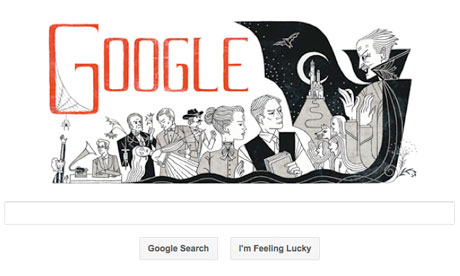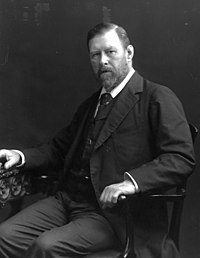Abraham "Bram" Stoker (8 November 1847 – 20 April 1912) was an Irish novelist and short story writer, best known today for his 1897 Gothic novel Dracula. During his lifetime, he was better known as personal assistant of actor Henry Irving and business manager of the Lyceum Theatre in London, which Irving owned. Stoker was born on 8 November 1847 at 15 Marino Crescent, Clontarf, on the northside of Dublin, Ireland.[1][2] His parents were Abraham Stoker (1799–1876), from Dublin, and Charlotte Mathilda Blake Thornley (1818–1901), who came from Ballyshannon, a town in County Donegal. Stoker was the third of seven children, the eldest of whom was Sir Thornley Stoker, 1st Bt.[3] Abraham and Charlotte were members of the Church of Ireland Parish
of Clontarf and attended the parish church with their children, who were baptised there. Stoker was bedridden until he started school at the age of seven, when he made a complete recovery. Of this time, Stoker wrote, "I was naturally thoughtful, and the leisure of long illness gave opportunity for many thoughts which were fruitful according to their kind in later years." He was educated in a private school run by the Rev. William Woods.[4] After his recovery, he grew up without further major health issues, even excelling as an athlete (he was named University Athlete) at Trinity College, Dublin, which he attended from 1864 to 1870. He graduated with honours as a B.A. in Mathematics. He was auditor of the College Historical Society ('the Hist') and president of the University Philosophical Society, where his first paper was on "Sensationalism in Fiction and Society". Early career Stoker became interested in the theatre while a student through a friend, Dr. Maunsell. He became the theatre critic for the Dublin Evening Mail, co-owned by the author of Gothic tales Joseph Sheridan Le Fanu. Theatre critics were held in low esteem but he attracted notice by the quality of his reviews. In December 1876 he gave a favourable review of Henry Irving's Hamlet at the Theatre Royal in Dublin. Irving invited Stoker for dinner at the Shelbourne Hotel, where he was staying. They became friends. Stoker also wrote stories, and in 1872 "The Crystal Cup" was published by the London Society, followed by "The Chain of Destiny" in four parts in The Shamrock. In 1876, while a civil servant in Dublin, Stoker wrote a non-fiction book (The Duties of Clerks of Petty Sessions in Ireland, published 1879), which remained a standard work .[4] Furthermore, he possessed an interest in art, and was a founder of the Dublin Sketching Club in 1874.[5] Lyceum Theatre and later career Bram Stoker's former home, Kildare Street, Dublin, Ireland. In 1878 Stoker married Florence Balcombe, daughter of Lieutenant-Colonel James Balcombe of 1 Marino Crescent. She was a celebrated beauty whose former suitor was Oscar Wilde.[6] Stoker had known Wilde from his student days, having proposed him for membership of the university’s Philosophical Society while he was president. Wilde was upset at Florence's decision, but Stoker later resumed the acquaintanceship, and after Wilde's fall visited him on the
Continent.[7] The Stokers moved to London, where Stoker became acting manager and then business manager of Irving's Lyceum Theatre, London, a post he held for 27 years. On 31 December 1879, Bram and Florence's only child was born, a son whom they christened Irving Noel Thornley Stoker. The collaboration with Irving was important for Stoker and through him he became involved in London's high society, where he met James Abbott McNeill Whistler and Sir Arthur Conan Doyle (to whom he was distantly related). Working for Irving, the most famous actor of his time, and managing one of the most successful theatres in London made Stoker a notable if busy man. He was dedicated to Irving and his memoirs show he idolised him. In London Stoker also met Hall Caine, who became one of his closest friends - he dedicated Dracula to him. In the course of Irving's tours, Stoker travelled the world, although he never visited Eastern Europe, a setting for his most famous novel. Stoker enjoyed the United States, where Irving was popular. With Irving he was invited twice to the White House, and knew William McKinley and Theodore Roosevelt. Stoker set two of his novels there, using Americans as characters, the most notable being Quincey Morris. He also met one of his literary idols, Walt Whitman. The first edition cover of Dracula Writings While manager for Irving, and secretary and director of London's Lyceum Theatre, he began writing novels beginning with The Snake's Pass in 1890 and Dracula in 1897. During this period, Stoker was part of the literary staff of the London Daily Telegraph and wrote other fiction, including the horror novels The Lady of the Shroud (1909) and The Lair of the White Worm (1911).[8] In 1906, after Irving's death, he published his life of Irving, which proved successful,[4] and managed productions at the Prince of Wales Theatre. Before writing Dracula, Stoker met Ármin Vámbéry who was a Hungarian writer and traveler. Dracula likely emerged from Vámbéry's dark stories by Carpathian mountains.[9] Stoker then spent several years researching European folklore and mythological stories of vampires. Dracula is an epistolary novel, written as a collection of realistic, but completely fictional, diary entries, telegrams, letters, ship's logs, and newspaper clippings, all of which added a level of detailed realism to his story, a skill he developed as a newspaper writer. At the time of its publication, Dracula was considered a "straightforward horror novel" based on imaginary creations of supernatural life.[8] "It gave form to a universal fantasy . . . and became a part of popular culture."[8] According to the Encyclopedia of World Biography, Stoker's stories are today included within the categories of "horror fiction," "romanticized Gothic" stories, and "melodrama."[8] They are classified alongside other "works of popular fiction" such as Mary Shelley's Frankenstein[10]:394 which, according to historian Jules Zanger, also used the "myth-making" and story-telling method of having "multiple narrators" telling the same tale from different perspectives. "'They can't all be lying,' thinks the reader."[11] The original 541-page manuscript of Dracula, believed to have been lost, was found in a barn in northwestern Pennsylvania during the early 1980s.[12] It included the typed manuscript with many corrections, and handwritten on the title page was "THE UN-DEAD." The author's name was shown at the bottom as Bram Stoker. Author Robert Latham notes, "the most famous horror novel ever published, its title changed at the last minute."[10] The manuscript was purchased by Microsoft co-founder Paul Allen. Stoker's inspirations for the story, in addition to Whitby, may have included a visit to Slains Castle in Aberdeenshire, a visit to the crypts of St. Michan's Church in Dublin and the novella Carmilla by Joseph Sheridan Le Fanu.[13] Stoker's original research notes for the novel are kept by the Rosenbach Museum and Library in Philadelphia, PA. A facsimile edition of the notes was created by Elizabeth Miller and Robert Eighteen-Bisang in 1998. Death In Golders Green After suffering a number of strokes, Stoker died at No. 26 St George's Square on 20 April 1912.[14] Some biographers attribute the cause of death to tertiary syphilis,[15] others to overwork.[16] He was cremated, and his ashes placed in a display urn at Golders Green Crematorium. After Irving Noel Stoker's death in 1961, his ashes were added to that urn. The original plan had been to keep his parents' ashes together, but after Florence Stoker's death, her ashes were scattered at the Gardens of Rest. To visit his remains at Golders Green, visitors must be escorted to the room the urn is housed in, for fear of vandalism. Beliefs and philosophy Stoker was brought up as a Protestant, in the Church of Ireland. He was a strong supporter of the Liberal party. He took a keen interest in Irish affairs[4] and was what he called a "philosophical home ruler", believing in Home Rule for Ireland brought about by peaceful means - but as an ardent monarchist he believed that Ireland should remain within the British Empire which he believed was a force for good. He was a great admirer of Prime Minister William Ewart Gladstone, whom he knew personally, and admired his plans for Ireland.[17] Stoker had a strong interest in science and medicine and a belief in progress. Some of his novels like The Lady of the Shroud (1909) can be seen as early science fiction. Stoker had an interest in the occult especially mesmerism, but was also wary of occult fraud and believed strongly that superstition should be replaced by more scientific ideas. In the mid 1890s, Stoker is rumoured to have become a member of the Hermetic Order of the Golden Dawn, though there is no concrete evidence to support this claim.[18][19][20] One of Stoker's closest friends was J.W. Brodie-Innis, a major figure in the Order, and Stoker himself hired Pamela Coleman Smith, as an artist at the Lyceum Theater. Posthumous
Bram Stoker Books Google Doodle [HQ]
Password:
Password:
How to Download???
















No comments:
Post a Comment